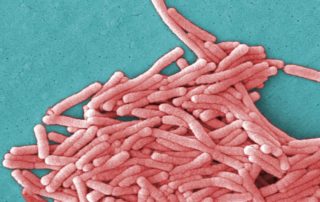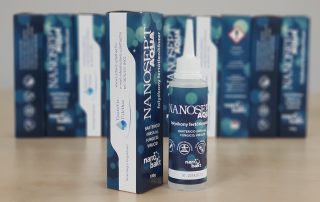KNOWLEDGE BASE
Legionella pneumophila
Legionella is a bacterial genus comprising at least 50 species, of which Legionella pneumophila should be singled out as it is primarily reponsible for fatal legionellosis infections in some cases. The pathogenic role of the bacterium was not recognized until 1976, all of which came to light when a sudden outbreak of pneumonia broke out among Pennsylvania veterans in an air-conditioned hostel (hence the disease is called legionaires’ disease). Legionella bacteria can form a cohesive coating called biofilm, which can make it difficult to remove with conventional disinfectants. Due to the combined effect of the stabilized silver colloid and hydrogen peroxide, Nanosept is also able to destroy the pathogen hidden in the already formed biofilm and under its protection.
Pseudomonas aeruginosa
The genus Pseudomonas contains more than 140 species of bacteria, of which Pseudomonas aeruginosa has received the most attention, as this species is the most common cause of infections in humans. In addition to air conditioners, bacteria that settle in the humid environment of drains, toilet cisterns, hand basins and faucets rarely cause disease in people with healthy immune system, but in the case of weakened immune systems these infections show a high mortality rate. Pseudomonas is resistant to traditional disinfectants, so it is important to choose a more effective solution than these. Such is the Nanosept product family, which due to the effect of stabilized silver colloid and hydrogen peroxide is able to destroy pathogens hidden in biofilms.
Chlorine-free disinfection of home pools
Have you ever wished that after bathing in the garden pool, your clothes did not smell like chlorine and your eyes did not turn red? Nanosept Aqua is just as easy to use as chlorine, but it provides long-term protection against Legionella and Pseudomonas bacteria. In addition, it avoids the disadvantages of chlorinated water disinfection.
Nanosept and Nanosept Aqua: new generation disinfectants for home usage
Bacterial or fungal species can occur not only in hospitals, but also in our home environment, against which it is worthwhile to protect ourselves with the most effective disinfection. Although these infections are not common, they can be all the more dangerous. An example is the bacterium Legionella, which can be present in whirlpools, fountains, sprayers, or garden sprinkles, but also in the water of poorly maintained and uncleaned air conditioners. The bacterium can even cause a fatal infection, so if you use air conditioners, it is worthwhile to minimize the risk of developing an infection. In addition to Legionella, several species of bacteria and fungi that even settle in our homes can cause even milder or more serious diseases. If we want a long-term and effective solution for disinfecting our home spaces, it is worth trying modern disinfectants based on the latest technology and now available to the public.



